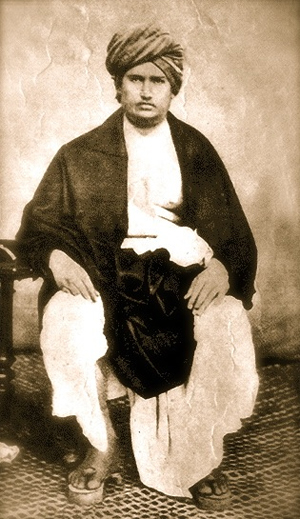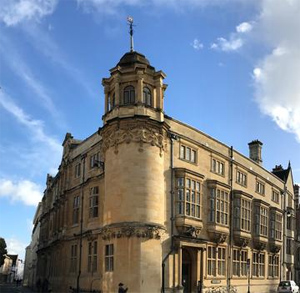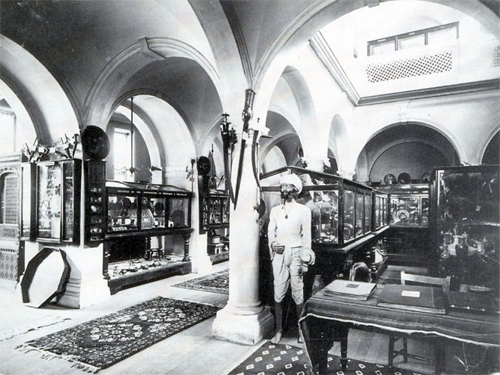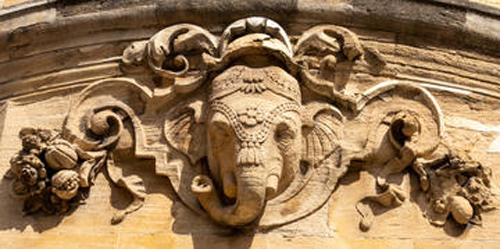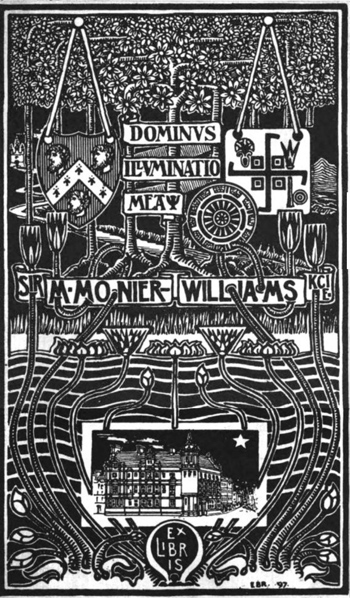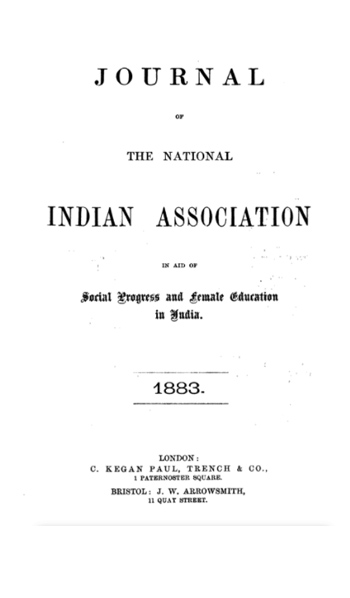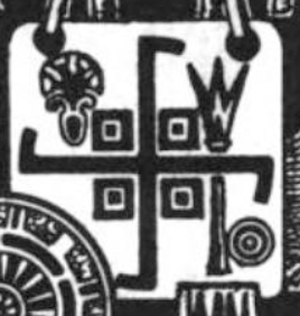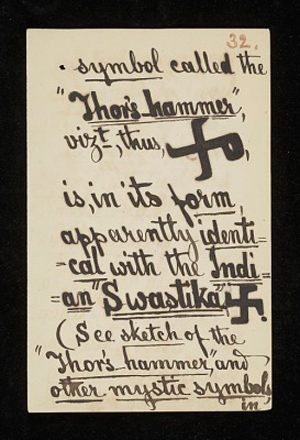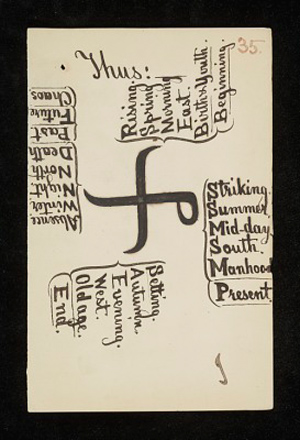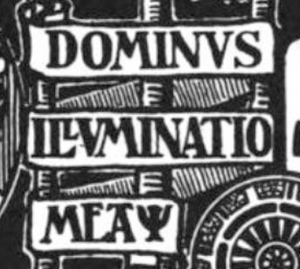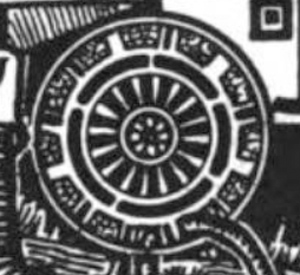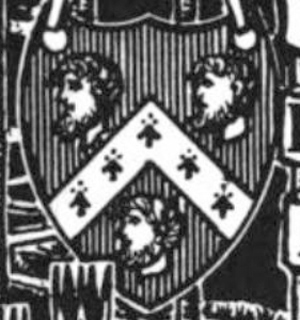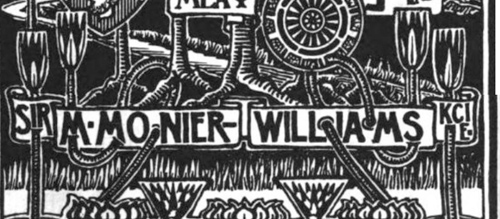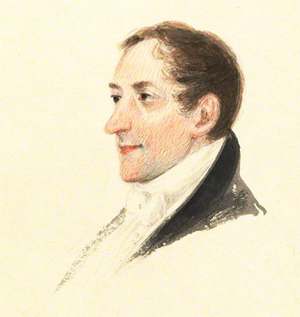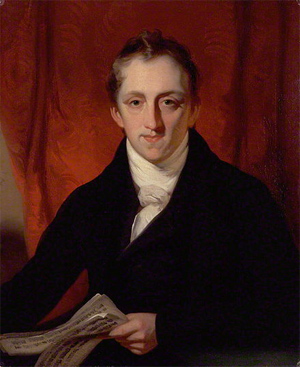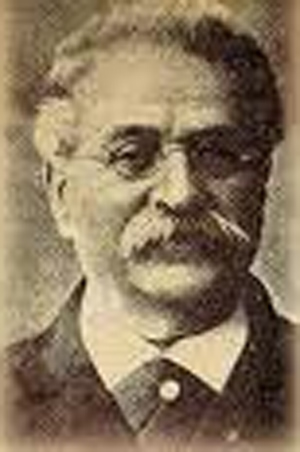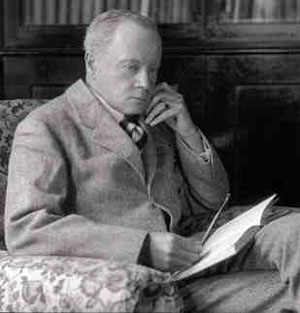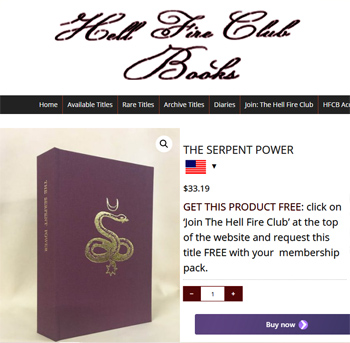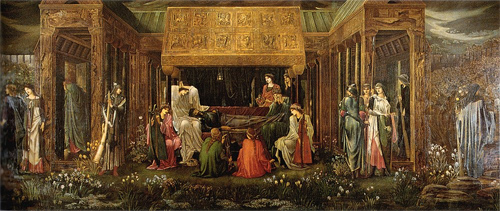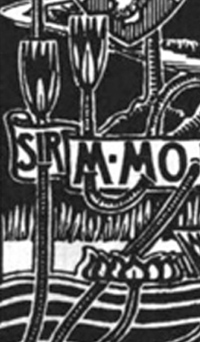by Theosophy Wiki
Accessed: 3/21/21
1879, Excerpt from Masters and Men: The Human Story in the Mahatma Letters (a fictionalized account)
by Virginia Hanson
The Theosophical Publishing House
Madras, India
c 1980 The Theosophical Publishing House
Most of the Letters are over the signature of the Mahatma Koot Hoomi, usually signed simply "K.H." A Kashmiri Brahmin by birth, at the time of the correspondence he was a Buddhist. Koot Hoomi is a mystical name which he instructed H.P.B. to use in connection with his correspondence with Mr. Sinnett. It is possible that his real name was Nisi Kanta Chattopadhyaya, as that seems to have been the name by which he was known when he was attending at least one European University. He was fluent in both English and French and was sometimes affectionally spoken of by the Mahatma Morya as "my Frenchified K.H."
At one time, under special circumstances, the Mahatma Morya took over the correspondence temporarily. He too used only his initial as a signature. "He was a Rajput by birth," said H.P.B., "One of the warrior race of the Indian desert, the finest and handsomest nation in the world." He was "a giant, six feet eight, and splendidly built; a superb type of manly beauty." The Mahatma K.H. referred to him humorously as "my bulky brother." He was not proficient in English and spoke of himself as using words and phrases "lying idle in my friend's brain" -- meaning, of course, the brain of the Mahatma K.H.In 1870, the same year that Keshub visited England, two other Indians took ship from England to America. They were a Bombay textile magnate called Moolji Thackersey (Seth Damodar Thackersey Mulji, died 1880) and Mr. Tulsidas. Josephine Ransom, an early historian of the Theosophical Society, writes that they were “on a mission to the West to see what could be done to introduce Eastern spiritual and philosophic ideas.” Traveling on the same boat was Henry Olcott, fresh from his experiences in London’s spiritualist circles. Olcott was sufficiently impressed by this shipboard meeting to keep a framed photograph of the two Indians on the wall of the apartment he was sharing with Blavatsky in 1877. It was one evening in that year that a visitor who had traveled in India (sometimes identified as James Peebles) remarked on the photograph. Olcott writes in his memoirs of the consequences of this extraordinary series of coincidences:I took it down, showed it to him, and asked if he knew either of the two. He did know Moolji Thackersey and had quite recently met him in Bombay. I got the address, and by the next mail wrote to Moolji about our Society, our love for India and what caused it. In due course he replied in quite enthusiastic terms, accepted the offered diploma of membership, and told me about a great Hindu pandit and reformer, who had begun a powerful movement for the resuscitation of pure Vedic religion.
This reformer was Swami Dayananda Saraswati (1824-1882). In 1870 he was still an eccentric traveling preacher with no aspirations to international influence: something that grew on him precisely after meeting the Brahmo Samajists. He met Devandranath [Debendranath] Tagore in 1870; in 1873 Keshub Chunder Sen gave him the advice (which he took) to stop wearing only a loincloth and speaking only Sanskrit. Indefatigably stumping round the subcontinent, Dayananda founded his “powerful movement,” the Arya Samaj, in 1875. This chronology suggests that in 1870 Thackersey was probably coming to America as a representative of the Brahmo Samaj, but that by the time Olcott got in touch with him again, he had transferred his allegiance to the Arya Samaj.
The Arya Samaj was more radical than any wing of the Brahmo Samaj, on which it was partially modeled. Dayananda was a monotheist who believed in the Vedas as the sole revealed scripture and the basis for a universal religion. The various gods addressed in the Vedic hymns (Agni, Indra, etc.), he explained as aspects of the One, and he was prepared to demonstrate how these ancient texts contained all possible knowledge of man, nature, and the means of salvation and happiness. Of the quarrels between the various religions, he wrote: “My purpose and aim is to help in putting an end to this mutual wrangling, to preach universal truth, to bring all men under one religion so that they may, by ceasing to hate each other and firmly loving each other, life in peace and work for their common welfare.” He had no respect whatever for Brahmanism: for their scriptures, rituals, polytheism, caste system, and discrimination against women. Unfortunately for his opponents, he was immensely learned and articulate, could out-argue most pundits, and had, in the last resort (which often seems to have occurred) the advantage of being 6’9” tall and broad to match.
From Dayananda’s point of view, the Brahmo Samajists had erred both in their failure to recognize the supremacy of the Vedas, and in their too-ready embrace of the errors of other religions. They were moreover too addicted to Brahmanic customs and privileges. Here is a contemporary summary of his social principles:He says that no inhabitant of India should be called a Hindu, that an ignorant Brahmin should be made a Shudra, and a Shudra, who is learned, well-behaved and religious should be made a Brahmin. Both men and women should be taught Language, Grammar, Dharmashastras, Vedas, Science and Philosophy. Women should receive special education in Chemistry, Music and Medical Science; they should know what foods promote health, strength and vigour. He condemns child marriage as the root of the most of the evils. A girl should be educated and married at the age of twenty. If a widow wants to remarry, she should be allowed to do so. According to his opinion, there is no particular difference between the householder and the sannyasi.
It is not surprising that the Theosophists in New York took kindly to the Arya Samaj, at first through correspondence with Thackersey, then through the Bombay branch head, Hurrychund Chintamon, and lastly through Dayananda himself. The two societies were united for a time, though the Theosophists were disillusioned as soon as they discovered the strength of Dayananda's Vedic fundamentalism and his hostility to all other religions. On Dayananda's unexpected death, Blavatsky wrote a generous obituary in The Theosophist for December 1883. She appreciated him for defending what he saw as the best of his native heritage against the priestcraft of Brahmins and Christians alike, and for his leadership in an enlightened social policy of which she could only have approved.
As the Arya Samaj continued to flourish after Dayananda's death, it became a rallying point for that movement of Hindu nationalism that wanted neither to turn back the clock to Brahmanic theocracy, nor to embrace Western materialism along with the benefits of science and technology. What Rammohun Roy had set in motion, the Arya Samaj carried forward into the era of the Indian National Congress and the independence movement of the twentieth century. Dayananda himself died -- some said poisoned -- at the time when his mission was beginning to have real success among the North Indian rulers, but he had done enough to be celebrated as a father-figure by leaders of Indian independence such as [url]Jawaharlal Nehru[/url], Mahatma Gandhi, Indira Gandhi, and Aurobindo Ghose.
-- The Theosophical Enlightenment, by Joscelyn Godwin
-- Swami Dayanand's Charges, by Colonel Henry S. Olcott
-- Dayananda Saraswati, by New World Encyclopedia
-- Dayananda Saraswati [Mul Shankar Tiwari], by Wikipedia
-- Chapter 6: Text-based Identity: Dayanand Saraswati's Reconstruction of the Aryan Self, from Aryans, Jews, Brahmins: Theorizing Authority through Myths of Identity, by Dorothy M. Figueira
-- Arya Samaj, by Wikipedia
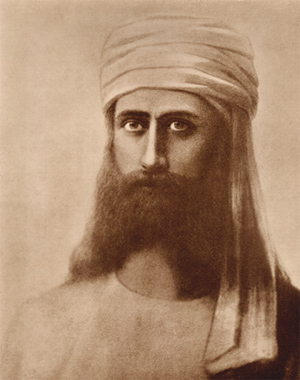
Portrait by H. Schmiechen

Morya's initial from Mahatma Letter No. 36
Morya (frequently referred to simply as M.) was H. P. Blavatsky's Master and one of the Mahatmas that inspired the founding of the Theosophical Society. He engaged in a correspondence with two English Theosophists living in India, A. P. Sinnett and A. O. Hume, when Mahatma K.H. went into retreat for a few months. This correspondence was published in the book The Mahatma Letters to A. P. Sinnett. In addition, letters to H. P. Blavatsky, Colonel Olcott, and others were published in Letters from the Masters of the Wisdom.
Personal features
Charles Johnston interviewed H. P. Blavatsky and asked her about the Masters. In the following excerpt Johnston describes his impression about Master M.'s handwriting as opposed to that of Master K.H., and then Mme. Blavatsky gives some information about her Master:
"The red [handwriting] . . . is fierce, impetuous, dominant, strong; it comes in volcanic outbursts, while the other [Master K.H.'s] is like Niagara Falls. One is fire, and the other is the ocean. They are wholly different, and both quite unlike yours. But the [red handwriting] has more resemblance to yours. . . ."
"This is my Master," she said, "whom we call Mahatma Morya. I have his picture here." And she showed me a small panel in oils. If ever I saw genuine awe and reverence in a human face, it was in hers, when she spoke of her Master. He was a Rajput by birth, she said, one of the old warrior race of the Indian desert, the finest and handsomest nation in the world. Her Master was a giant, six feet eight, and splendidly built; a superb type of manly beauty. Even in the picture, there is a marvellous power and fascination; the force, the fierceness even, of the face; the dark, glowing eyes, which stare you out of countenance; the clear-cut features of bronze, the raven hair and beard—all spoke of a tremendous individuality, a very Zeus in the prime of manhood and strength. I asked her something about his age. She answered:
"My dear, I cannot tell you exactly, for I do not know. But this I will tell you. I met him first when I was twenty,—in 1851. He was in the very prime of manhood then. I am an old woman now, but he has not aged a day. He is still in the prime of manhood. That is all I can say. You may draw your own conclusions."[1]
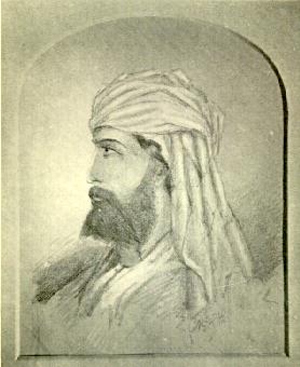
Portrait produced by Monsieur Harrisse at the "Lamasery" in New York
A Rajput (from Sanskrit raja-putra, “son of a king”) is a member of one of the patrilineal clans of western, central, northern India and some parts of Pakistan. They claim to be descendants of ruling Hindu warrior classes of North India. The Mahatma's clan was confirmed by him in a letter sent to A. P. Sinnett when he said: "My Rajput blood will never permit me to see a woman hurt in her feelings..."[2]
Master K.H., in another letter to Mr. Sinnett, describes Morya as follows:
You . . . will hardly if ever be able to appreciate such characters as Morya's: a man as stern for himself, as severe for his own shortcomings, as he is indulgent for the defects of other people, not in words but in the innermost feelings of his heart; for, while ever ready to tell you to your face anything he may think of you, he yet was ever a stauncher friend to you than myself, who may often hesitate to hurt anyone's feelings, even in speaking the strictest truth.[3]
Again, according to Master K.H., Morya "is better and more powerful than I"[4]
Master M. knew very little English and didn't like to write.
Mme. Blavatsky, in a letter to Mrs. Hollis Billings wrote:
Now Morya lives generally with Koot-Hoomi who has his house in the direction of the Kara Korum Mountains, beyond Ladak, which is in Little Tibet and belongs now to Kashmire. It is a large wooden building in the Chinese fashion pagoda-like, between a lake and a beautiful mountain.[5]
Relationship with Mme. Blavatsky
H. P. Blavatsky was a disciple of Master M. The Countess Constance Wachtmeister wrote in her Reminiscenses of H.P. Blavatsky how she met him:
During her childhood [Madame Blavatsky] had often seen near her an Astral form, that always seemed to come in any moment of danger, and save her just at the critical point. HPB had learnt to look upon this Astral form as a guardian angel, and felt that she was under His care and guidance. In London, in 1851, she was one day out walking when, to her astonishment, she saw a tall Hindu in the street with some Indian princes. She immediately recognized him as the same person that she had seen in the Astral. Her first impulse was to rush forward to speak to him, but he made her a sign not to move, and she stood as if spellbound while he passed on. The next day she went into Hyde Park for a stroll, that she might be alone and free to think over her extraordinary adventure. Looking up, she saw the same form approaching her, and then her Master told her that he had come to London with the Indian princes on an important mission, and he was desirous of meeting her personally, as he required her cooperation in a work which he was about to undertake. He then told her how the Theosophical Society was to be formed, and that he wished her to be the founder. He gave her a slight sketch of all the troubles she would have to undergo, and also told her that she would have to spend three years in Tibet to prepare her for the important task. HPB decided to accept the offer made to her and shortly afterwards left London for India.[6]
It is possible that Countess Wachtmeister confused the date with H. P. Blavatsky’s previous visit with her father to London in the '40s. Mme. Blavatsky wrote to Mr. Sinnett: "I was in London and France with Father in '44 not 1851." Though in this letter she explains that she does not remember well what happened in years past, she told Mr. Sinnett how she met the Master:
I saw Master in my visions ever since my childhood. In the year of the first Nepaul Embassy (when?) saw and recognised him. Saw him twice. Once he came out of the crowd, then He ordered me to meet Him in Hyde Park. I cannot, I must not speak of this. I would not publish it for the world.[7]
Blavatsky on the name "Morya"
The name Morya is the same as that of the Maurya clan, which ruled India from 322-185 BCE. The invincible Chandragupta Maurya, founder of the Maurya Empire, united the Indian subcontinent, while his grandson, Ashoka the Great, adopted Buddhism and sent missions to other parts of Asia as well as the Mediterranean world. In the Mahaparinibbana Sutta, an early Buddhist text that records the end of Gautama Buddha’s life, the “Moriyas of Pipphalavana” are said to have “built a great stupa for the embers” that remained from the cremation.[8] This passage suggests that there was already a connection between the Maurya clan and Buddhism. Blavatsky claims that long after the fall of the Mauryan Empire, the Mauryas (or Moryas) continued to have a deep connection with Buddhism. In 436 CE an Arhat (Buddhist saint) named Kasyapa, who belonged to the Morya clan, left an Indian convent in Panch-Kukkutarama with the fifth of seven golden statues of the Buddha, which he carried to a lake in Bod-yul (Tibet), thereby fulfilling an ancient prophecy. Seven years later the first Buddhist monastery was established on that spot, although the conversion of the country did not begin in earnest till the 7th century. Most of the abbots of that monastery “were the descendants of the dynasty of the Moryas, there being up to this day three of the members of this once royal family living in India.”[9]
H. P. Blavatsky explicitly affirms a link between the Shakya clan, to which Gautama Buddha belonged, and the Moriya clan, stating that the former founded a town called Moriya-Nagara. She adds that the Rajput tribe of Mori owes its name to being “composed of the descendants of the first sovereign of Moriya, Nagari-Môrya,” and that the Moryas are Kshatriyas, unlike Master Koot Hoomi and the Rishi Koothumi who are “Northern Brahmans.”[10] The name Moriya probably derives from mayura or mora, which means peacock.[11] The peacock image connects this warrior clan with Karttikeya, the Hindu war god, whose vehicle is a peacock, and possibly with the Buddhist “Peacock Lord,” a Wisdom King (Kujaku-myoo in Japan, the female Mahamayuri in India).
Col. Olcott's meeting with the Master Morya
In a letter from Henry S. Olcott to Allan O. Hume about the Mahatmas, printed by Mr. Hume in his "Hints on Esoteric Theosophy":
One evening, at New York, after bidding H. P. B. good night, I sat in my bed-room, finishing a cigar and thinking. Suddenly there stood my Chohan beside me. The door had made no noise in opening, if it had been opened, but at any rate there he was. He sat down and conversed with me in subdued tones for some time, and as he seemed in an excellent humour towards me, I asked him a favour. I said I wanted some tangible proof that he had actually been there, and that I had not been seeing a mere illusion or maya conjured up by H. P. B. He laughed, unwound the embroidered Indian cotton fehta he wore on his head, flung it to me, and – was gone. That cloth I still possess, and it bears in one corner the initials ( ___ ) of my Chohan in thread-work.[12]
Letters written by M.
M. engaged in a correspondence with two English Theosophists living in India, A. P. Sinnett and A. O. Hume, when Mahatma K.H. went into retreat for a few months. This correspondence was published in the book The Mahatma Letters to A. P. Sinnett. In addition, letters to H. P. Blavatsky, Colonel Olcott, and others were published in Letters from the Masters of the Wisdom.
For a complete list of Master M.'s letters that were published in these sources, see Category:ML from Morya.
Writing style
C. Jinarājadāsa commented on M.'s style of writing:
When reading the letters of Master M., we must not forget that He is of quite a different temperament to Master K.H. He is far more steeped in Indian atmosphere than His Brother. Both show a keen sense of humour, but while that of the Master K.H. is more akin to the French notion of wit, that of the Master M. is far more allied to what the Greek tragedians meant by “irony”. Irony excludes ridicule completely. It contrasts, with great dispassion, facts as they are with what they are supposed to be. Those who can appreciate the Master’s “irony” find great inspiration in the glimpses gained of things seen from His angle of vision.[13]
As for the handwriting, he wrote:
All the letters of the Master M., which Mr. Sinnett and others received from 1881 onwards, are in a script which the Master Himself has acknowledged as sometimes difficult to decipher. But before 1881, the Master used another script, a specimen of which is given in Letter 28. This earlier script is small and neat, easy to read. There is evidence that at this time He used a third script, though only once, and this is shown in the brief Letter 34.
There is a great mystery, not yet solved, as to the use of various scripts by the Masters and Their pupils. Not all the letters were precipitated by the Masters, as H.P.B. has clearly explained. Some were precipitated by Chelas, on general instructions from the masters. Some of the Masters knew European languages; others did not. The Master M. at this time knew no English at all, and when writing had to use the translation of His thought in the brain of some pupil, like H.P.B., Colonel Olcott and others. Sometimes he took the language from the brain of the Master K.H..[14]
Account by C. W. Leadbeater
In his book The Masters and the Path C. W. Leadbeater describes Master M as follows:
He is a Rajput King by birth, and has a dark beard divided into two parts, dark, almost black, hair falling to His shoulders, and dark and piercing eyes, full of power. He is six feet six inches in height, and bears Himself like a soldier, speaking in short terse sentences as if He were accustomed to being instantly obeyed. In His presence there is a sense of overwhelming power and strength, and He has an imperial dignity that compels the deepest reverence.[15]
Online resources
Articles
• Morya, Mahatma in Theosophy World.
• Colonel Henry S. Olcott's Testimony about His Meetings with the Master Morya in Blavatsky Study Center.
• Portrait of the Master Morya by J. D. Buck.
• In the Days of H.P.B. Master M.'s Visit to Madras in 1874 by G. Subbiah Chetty.
Notes
1. Helena Petrovna Blavatsky, Collected Writings vol. VIII (Adyar, Madras: Theosophical Publishing House, 1960) 399-400
2. Vicente Hao Chin, Jr., ed., The Mahatma Letters to A.P. Sinnett in chronological sequenceNo. 29 (Quezon City: Theosophical Publishing House, 1993), 91. See Mahatma Letter No. 29, page 13.
3. Vicente Hao Chin, Jr., ed., The Mahatma Letters to A.P. Sinnett in chronological sequenceNo. 74 (Quezon City: Theosophical Publishing House, 1993), 224. See Mahatma Letter No. 74, page 11-12.
4. Vicente Hao Chin, Jr., ed., The Mahatma Letters to A.P. Sinnett in chronological sequenceNo. 65 (Quezon City: Theosophical Publishing House, 1993), 170. See Mahatma Letter No. 65.
5. Gottfried de Purucker, The Theosophical Forum Vol VIII, No. 5 (Point Loma, California, May 1936), 343-346.
6. Constance Wachtmeister, Reminiscenses of H.P. Blavatsky (Wheaton: The Theosophical Publishing House, 1976) 44.
7. A. Trevor Barker, (ed) The Letters of H. P. Blavatsky to A. P. Sinnett (London: 1925) 150-151, available at Theosophical University Press Online Edition
8. Maurice Walshe, trans., The Long Discourses of the Buddha: A Translation of the Digha Nikaya (Boston: Wisdom Publications, 1995) 276-277 (Mahaparinibbana Sutta 16.6.25-26.
9. “Shakyamuni’s Place in History” in H. P. Blavatsky Collected Writings V 245-246
10. "The Puranas on the Dynasties of the Moriyas and the Koothoomi” in H. P. Blavatsky Collected Writings VI 40-42.
11. P. Thankappan Nair, “The Peacock Cult in Asia,” in Asian Folklore Studies, Vol. 33, No. 2 (1974), 124, Nanzan University.
12. A. O. Hume, "Hints on Esoteric Theosophy" No. 1 (Calcutta, Calcutta Central Press Co., 1882, 2nd Edition) 79.
13. C. Jinarajadasa, Letters from the Masters of the Wisdom, Second Series (Adyar, Madras, India: Theosophical Publishing House, 1925), 140-141.
14. C. Jinarajadasa, Letters from the Masters of the Wisdom, Second Series (Adyar, Madras, India: Theosophical Publishing House, 1925), 66.
15. C. W. Leadbeater, The Masters and the Path (Adyar, Madras: The Theosophical Publishing House, 1984), 24.
**************************
Morya (Theosophy)
by Wikipedia
Accessed: 3/21/21
Morya is one of the "Masters of the Ancient Wisdom" within modern Theosophical beliefs. He is one of the Mahatmas who inspired the founding of the Theosophical Society and was engaged in a correspondence with two English Theosophists living in India, A. P. Sinnett and A. O. Hume. The correspondence was published in 1923 by A. Trevor Barker, in the book The Mahatma Letters to A. P. Sinnett.
History

A portrait of Master Morya by Hermann Schmiechen
H. P. Blavatsky, originally described the existence of a spiritual master whom she considered her guru, and who went by, among other names, Morya. Blavatsky said that Morya and another master, Koot Hoomi, were her primary guides in establishing the Theosophical Society. Blavatsky also wrote that Masters Morya and Koot Hoomi belonged to a group of highly developed humans known to some as the Great White Brotherhood or the White Lodge (though this is not how they described themselves). Master Morya's personality has been depicted in some detail by various theosophical authors. A man "living on the earth, but possessed of developed senses that laughed at time and space." [1] On the other hand, author P. Jenkins challenges that there is little evidence that Blavatsky's Masters, including Morya, ever existed.[2] Author K. Paul Johnson wrote that Blavatsky gave conflicting versions of her meeting with Morya and suggests Blavatsky fictionalized the story, basing it on her encounter with an Italian political activist.[3][4] Blavatsky's published works have been praised by New York papers as exhibiting immense research, in referring to her book Isis Unveiled, the New York Sun[5] writes, "the strange part of this is, as I and many others can testify as eye witnesses to the production of the book, that the writer had no library in which to make researches and possessed no notes of investigation or reading previously done. All was written straight out of hand. And yet it is full of references to books in the British Museum and other great libraries, and every reference is correct. Either, then, we have, as to that book [referring to Isis Unveiled], a woman who was capable of storing in her memory a mass of facts, dates, numbers, titles, and subjects such as no other human being ever was capable of, or her claim to help from unseen beings is just."
After Blavatsky's death, theosophists and others continued claiming to have met Morya or to have received communications from him. William Quan Judge, the leader of the American Section of the Theosophical Society, stated privately that he had received letters from Morya and other Adepts. Annie Besant, head of the European Section and co-head of the Esoteric Section with Judge, made public statements supporting the genuineness of those letters; but she later accused Judge of falsifying them, asserting that her suspicions of him were confirmed by the visitation of a Mahatma, presumably Master Morya, to whom she was linked.[6] The ensuing controversy led to the break-up of the Society in 1895, but leaders in the increasingly fragmented movement continued making claims about having received communications and visitations from the Masters connected with the cause. Theosophical writings offered vivid descriptions of Morya, his role in the Brotherhood, and his past lives.[7]
Incarnations
Morya's earliest notable claimed incarnation is recorded by Annie Besant and C.W. Leadbeater (from, the source states, their research into the "akashic records" at the Theosophical Society headquarters in Adyar (Tamil Nadu), India conducted in the summer of 1910) as having been the Emperor of Atlantis in 220,000 BC, ruling from his palace in the capital city, the City of the Golden Gates.[8]
According to the Ascended Masters teachings, some of the later incarnations that Morya is said to have had include:[9][10]
• Osho along with K.H(Devaraj)
• Melchior (one of the three wise men—the one who gave myrrh to Jesus)
• Abraham
• King Arthur of Camelot
• Thomas Becket (Archbishop of Canterbury)
• Thomas More
• Akbar (Mogul Emperor)
• Shams Tabrizi
• Thomas Moore
• Sergius of Radonezh
Ascension
Students of Ascended Master Activities believe that Morya ascended in 1898, becoming an Ascended Master and Chohan of the First Ray, and that his spiritual retreat is located at Darjeeling, India.[11][12][13]
References
1. "The sun. (New York [N.Y.]) 1833-1916, September 26, 1892, Image 5". 1892-09-26. p. 5. ISSN 1940-7831. Retrieved 2018-09-15.
2. Philip Jenkins, Mystics and Messiahs, p.41-42. Oxford University Press, 2000, NYC
3. K. Paul Johnson, The Masters Revealed: Madame Blavatsky and the Myth of the Great White Lodge (Albany: SUNY, 1994), 41.
4. Johnson, Paul K. Initiates of Theosophical Masters Albany, New York:1995 State University of New York Press
5. "The sun. (New York [N.Y.]) 1833-1916, September 26, 1892, Image 5". 1892-09-26. p. 5. ISSN 1940-7831. Retrieved 2018-09-15.
6. Annie Besant, The Case Against W. Q. Judge (1895), p. 13. About Besant’s closeness to Morya, in a letter of 27 March 1891 to Judge, Blavatsky writes: “She is not psychic nor spiritual in the least—all intellect—and yet she hears the Master's voice when alone, sees His Light, and recognises His Voice from that of D____.”
7. Letters of the Masters of the Wisdom: Second Series Nos. 69 and 70; First SeriesNo. 19; Wachtmeister, op. cit., Chapter 5.
8. Besant, Annie and Leadbeater, C.W. Man: How, Whence, and Whither? Adyar, India:1913 Theosophical Publishing House Page 122 Note: On page xii of the introduction it is explained that the name Mars is used to refer to the reincarnating soul entity now known to Theosophists as Morya in his various incarnations.
9. Prophet, Mark L. and Elizabeth Clare Lords of the Seven Rays Livingston, Montana, U.S.A.:1986 - Summit University Press - "Morya - Master of the First Ray" pages 21 - 78
10. Prophet, Elizabeth Clare and Prophet, Mark (as compiled by Annice Booth) The Masters and Their Retreats Corwin Springs, Montana:2003 Summit University Press Pages 87-92 El Morya
11. Luk, A.D.K.. Law of Life - Book II. Pueblo, Colorado: A.D.K. Luk Publications 1989.
12. Schroeder, Werner Ascended Masters and Their Retreats Ascended Master Teaching Foundation 2004.
13. Booth, Annice The Masters and Their Retreats Summit Lighthouse Library June 2003.
Sources
• Besant, Annie and Leadbeater, C.W. Man:How, Whence, and Whither? Adyar, India:1913—Theosophical Publishing House
• Leadbeater, C.W. The Masters and the Path Adyar, Madras, India: 1925—Theosophical Publishing House
• Prophet, Mark L. and Elizabeth Clare Lords of the Seven Rays Livingston, Montana, U.S.A.:1986 - Summit University Press
Further reading
• Campbell, Bruce F. A History of the Theosophical Movement Berkeley:1980 University of California Press
• Godwin, Joscelyn. The Theosophical Enlightenment Albany, New York: 1994 State University of New York Press
• Johnson, K. Paul The Masters Revealed: Madam Blavatsky and Myth of the Great White Brotherhood Albany, New York: 1994 State University of New York Press
• Melton, J. Gordon Encyclopedia of American Religions 5th Edition New York:1996 Gale Research ISBN 0-8103-7714-4 ISSN 1066-1212 Chapter 18--"The Ancient Wisdom Family of Religions" Pages 151-158; see chart on page 154 listing Masters of the Ancient Wisdom; Also see Section 18, Pages 717-757 Descriptions of various Ancient Wisdom religious organizations
• Cranston, Sylvia HPB: The Extraordinary Life and Influence of Helena Blavatsky G.P. Putnam's Sons, New York, 1993
See also
• https://en.wikiquote.org/wiki/The_Agele ... _Teachings
• Ascended masters
• Ascended Master Teachings
• Alice A.Bailey
• Helena Petrovna Blavatsky
• Benjamin Creme
• Hodgson Report
• Initiation (Theosophy)
• Master K.H.
• K.H. Letters to C.W. Leadbeater
• Mahātmā
• Helena Roerich
• Theosophy
External links
• Theosophical Society, The originators of the Master concept (Before the term "Ascended" was used)

